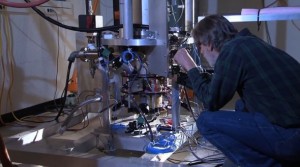Accurate Time – NIST Unveils New Atomic Clock With Potential To Keep Accurate Time For 300m Years
Accurate time specialists, Galleon Systems, assess the implications of NIST’s new atomic clock.
NIST (National Institute of Standards and Technology) has revealed a new atomic clock, claiming that it has the capability to maintain accurate time for the next 300 million years.
Dubbed NIST-F2, the new atomic clock has been labelled as the most accurate timekeeping apparatus ever developed and will become the U.S. civilian time and frequency standard.

Developers of the NIST-F2 have made the atomic clock free from all manner of background radiation malfunctions. The clock is considered to be at least three times more precise than the existing NIST-F1, which has supplied the ‘official’ source of time in the USA for 15 years, having been introduced in 1999.
Chief of NIST’s Time and Frequency Division, Thomas O’Brian, commented that the NIST-F2 is so precise it has the potential to sustain accurate time for a period of 300 million years. During this time, he claimed that the NIST-F2 atomic clock would not lose, or gain, a single second.
In an official statement, Mr O’Brian said: “Scientists at NIST are already working on the next generation of atomic clock that will be even better. So, while we’re celebrating this accomplishment, one of the burdens of being an atomic clock scientist is that you’re aware that the competition is always ahead of you.”
Physicist Steven Jefferts, who is a lead designer of the NIST-F2, said: “If we’ve learned anything in the last 60 years of building atomic clocks, we’ve learned that every time we build a better clock, somebody comes up with a use for it that you couldn’t have foreseen.”
NIST plans to operate the new NIST-F2 atomic clock, and the existing NIST-F1, concurrently from its campus base in Boulder, Colorado. In operating the clocks simultaneously they hope to measure which of them provides the most accurate time and record the results. Each clock utilises cesium atoms to establish the precise duration of a second.
When studying the cesium atom, NIST researchers calculate the frequency of a particular transition in the cesium atom – which exceeds more than 9.1 billion vibrations per second – to describe one second.
Mr O’Brian said that more accurate time is achieved by the F2 because the temperature of the environment surrounding it was reduced.
How to Achieve Accurate Time
What’s the best way to achieve accurate time?
Unfortunately, an atomic clock is not designed to fit in a standard server room. Therefore, in order to extract accurate time from an atomic clock, a new strategy had to be devised.
The best way to achieve accurate time across common workplace devices, such as computers, is to install a dedicated NTP time server. Galleon Systems’ NTP time servers, such as the NTS-6001-GPS, rely on UTC in order to synchronise time.
UTC accuracy is preserved by atomic clocks and with the presence of an NTP time server, accurate UTC time can be accessed and your dedicated NTP time server will distribute this accurate time across your entire computer network.
Would you like accurate time in your workplace? Visit www.galsys.co.uk and choose your new, dedicated NTP time server today…